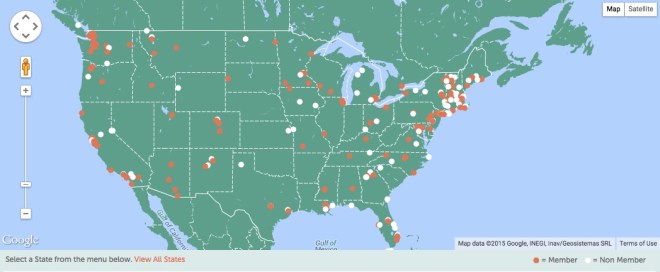I grew up in a gentrifying Brooklyn neighborhood. Thanks to the influx of wealthier newcomers, I have been displaced. Like most of my friends I grew up with in Park Slope, I have never been able to afford my own place in the neighborhood. But I look nothing like the typical image of a victim of gentrification. I’m white and upper-middle class. In fact, there are many whites who’ve been dislocated by gentrification. Think of the working class white ethnic enclaves — Irish South Boston, Italian South Philly, Polish Greenpoint in Brooklyn — being inundated with hipsters and yuppies.
It is nonetheless true, as Grist’s Brentin Mock points out, that the displaced are usually non-white. That’s partly because non-white communities usually have less wealth, home equity, and political power with which to resist displacement. It’s also because most white people voluntary fled cities in the second half of the 20th century, rather than stay and integrate. This has led to an unsustainable rise in segregation and concentrated poverty. The number of high-poverty neighborhoods have tripled since 1970.
It’s not that complicated to figure out why this displacement happens, though. In a market economy, prices are set by supply and demand. Raise the demand for something, without raising its supply by just as much, and prices will rise. Thus, the dearth of affordable housing in the most rapidly gentrifying neighborhoods and cities is the natural result of a privatized housing stock. You can’t expect private property owners in a free-market economy not to maximize their profit.
If displacement is just a byproduct of capitalism, then it stands to reason that the way to stop it is to take housing out of the free market. One way to limit rent increases is through rent control programs, but those are legendary for their inefficiencies and unintended consequences, such as decaying housing stocks and discouraging new construction. A growing cadre of community activists believe they have found another way.
The mechanism is called a community land trust, or CLT, which, as the name suggests, means community residents own the buildings and/or the land they sit on. Working through a nonprofit, they are able to keep housing at a rate that they collectively deem affordable, for families with incomes below a certain threshold. On average, CLT residents make just over 60 percent of the area’s median income. Longtime residents get to determine their community’s destiny instead of private developers determining it for them.
The first land trust was created in Albany, Ga., in 1968, the same year that Martin Luther King, Jr. was killed while campaigning to reverse years of disinvestment that had left impoverished black and Latino neighborhoods across the country. King’s cousin Slater King banded with social justice activist Robert Swann, a land trust pioneer, to build the Albany model called New Communities, Inc. It focused on helping black farmers retain land in rural areas. Swann and a growing battalion of housing advocates like Chuck Matthei began applying the land trust model in cities in the 1980s. It’s grown and multiplied across the nation ever since. In New Orleans, the Crescent City Community Land Trust has helped preserve affordable housing amid a wave of post-Katrina upgrades and rising rents.
Crescent City’s director Van Temple explained the CLT model to New Orleans’s public radio news outlet WWNO like this:
The typical affordable housing model in the country is that public money — which is usually federal in its origin — goes in to help make a home affordable, and then the strings attached to that money are usually 5-10 years long. … That means those number of years after that, the strings attached expire, so that home is essentially a market-rate home. It can be sold to whoever at the highest rate. The land trust model … guarantees that those [homes] are going to be affordable in perpetuity.
With rapidly rising home prices in many poor neighborhoods, more communities are turning to CLTs to help residents stay put when the rich people come. And when low-income residents do leave, CLTs ensure they will be replaced by people of similar means, guaranteeing some permanent measure of economic diversity.
“Interest has been skyrocketing recently,” says Emily Thaden, research and policy manager for the National Community Land Trust Network. “The only time there was an exception to these trends was the recent recession. Since the market has picked up in the last two to three years, we are contacted weekly, if not daily.”
The CLT network was incorporated in 2006 to support land trusts nationwide. Its network — which does not include all CLTs, but does include some other nonprofit affordable housing organizations — has 163 members in 46 states. They have approximately 13,000 homeownership units and over 20,000 rental units.

Map of member and non-member organizations of the National Community Land Trust Network.National Community Land Trust Network
The main challenge for CLTs is obtaining the land, because it’s not like these community nonprofits are awash in money. To compensate, they leverage funding for affordable housing development of all varieties: tax abatements, community development block grants, low-income housing tax credits, and even private capital. But the available capital and enabling policies vary by city and state.
“You don’t see a lot [of CLTs] in places where they hardly have any funding for affordable housing to begin with,”says Thaden. “Part of it is building political will for the concept, and part of it is having an infrastructure in place with enabling policies.”
Unfortunately, communities often realize they need a land trust only after prices have risen. It’s similar to how cities often don’t realize the market is strong enough that they can adopt inclusionary zoning, which sets aside a portion of new housing units for below-market rents, until after the building boom is well underway.
Some CLTs get out ahead of the wave enough to keep low-income residents in their community. In Chicago’s Albany Park neighborhood, a gentrifying, low-income, predominantly Latino neighborhood, a new CLT called Casas del Pueblo has been set up to stem the tide of displacement. As Chicago public radio affiliate WBEZ reports, there is even a CLT helping lower-income families buy in the affluent Chicago suburb of Highland Park. Improving economic diversity, after all, is a challenge that will require creating affordable housing in rich suburbs, not just preserving it in the inner-city.
So, we should be able to agree — contra Slate — that gentrification can lead to truly bad outcomes, especially if the displaced are just shifted to other impoverished neighborhoods. Concentrated poverty can lead to other problems like failing schools. A 2009 report from Ohio State’s Kirwin Institute for the Study of Race and Ethnicity found that “an increasing number of researchers … are identifying segregation — namely racial and class isolation — as a convergence point for factors that contribute to decreased academic performance.”
However, when gentrification is controlled through affordable housing policies, it can foster racial and socioeconomic integration, which benefits everyone. A recent report from PolicyLink and USC’s Program for Environmental and Regional Equity concluded that, “Every region of the country would be financially stronger with racial inclusion. Potential metro GDP gains range from $287 million per year in Springfield, Mo. (the lowest potential gain), to $510 billion per year in Los Angeles (the highest).”
CLTs can benefit even neighborhoods where gentrification never takes hold. In low-income communities, which are often highly transient, they add stability, as CLT homeowners are less likely to face foreclosure and CLT renters are less likely to get evicted. Unlike rent control, they do not create a disincentive to maintain apartment buildings or to build new ones. It’s basically a way for the community to take control of its own destiny before someone else does. If only someone had thought to put a CLT on my parents’ block, circa 1980.




